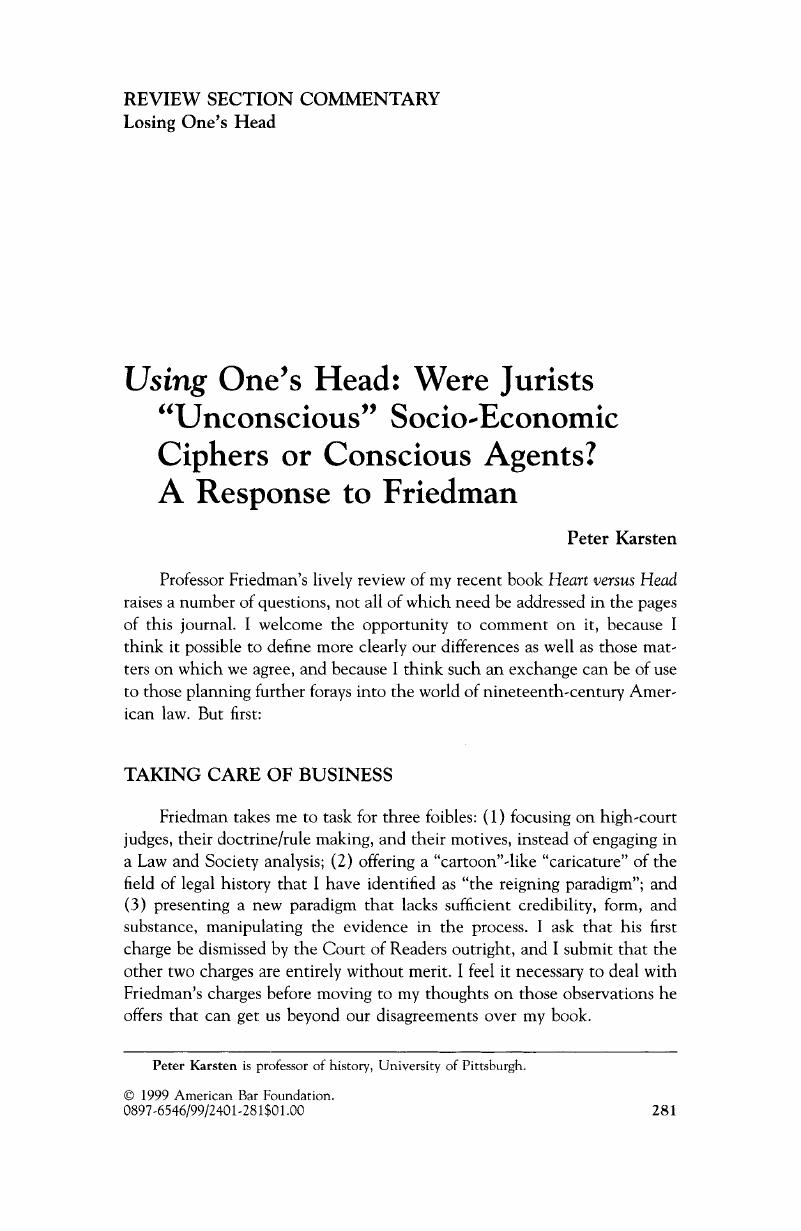No CrossRef data available.
Article contents
Using One's Head: Were Jurists “Unconscious” Socio-Economic Ciphers or Conscious Agents? A Response to Friedman
Published online by Cambridge University Press: 27 December 2018
Abstract
An abstract is not available for this content so a preview has been provided. Please use the Get access link above for information on how to access this content.

- Type
- Review Essay
- Information
- Copyright
- Copyright © American Bar Foundation, 1999
References
Bloomfield, Maxwell. 1976. American Lawyers in a Changing Society, 1776–1876. Cambridge, Mass.: Harvard University Press.Google Scholar
Butler, Diane H.
1995. Standing Against the Whirlwind: Evangelical Episcopalians in Nineteenth Century America. New York: Oxford University Press.Google Scholar
Cross, Whitney. 1950. The Burnt-Over District. Ithaca, N.Y.: Cornell University Press.Google Scholar
Farmer, Fannie. 1953. Legal Practice and Ethics in North Carolina, 1820–1860. North Carolina Historical Review
30:329–43.Google Scholar
Friedman, Lawrence. 1965. Contract Law in America: A Social and Economic Case Study. Madison: University of Wisconsin Press.Google Scholar
Friedman, Lawrence. 1985. A History of American Law. 2d ed. New York: Simon and Schuster.Google Scholar
Friedman, Lawrence. 1990. Opening the Time Capsule: A Progress Report on Studies of Courts over Time. Law and Society Review
24:229–40.Google Scholar
Friedman, Lawrence. 1999. Losing One's Head: Judges and the Law in Nineteenth-Century American Legal History. Law and Social Inquiry
24(1):253–79.Google Scholar
Gaustad, Edwin. 1973. Religion in American History and Historiography. Washington, D.C.: American Historical Association.Google Scholar
Hall, Kermit. 1989. The Magic Mirror: Law in American History. New York: Oxford University Press).Google Scholar
Horwitz, , Morton. The Transformation of American Law, 1780–1860. Cambridge, Mass.: Harvard University Press.Google Scholar
Hurst, James Willard. 1956. Law and the Conditions of Freedom in the Nineteenth Century United States. Madison: University of Wisconsin Press.Google Scholar
Karsten, Peter. 1997. Heart versus Head: Judge-Made Law in Nineteenth Century America. Chapel Hill: University of North Carolina Press.Google Scholar
Llewellyn, Karl. 1960. The Common Law Tradition: Deciding Appeals. Boston: Little Brown.Google Scholar
Miller, Perry. 1965. The Evangelical Basis. In The Life of the Mind in America. New York: Harcourt, Brace and World.Google Scholar
Orren, Karen. 1991. Belated Feudalism: Labor, the Law and Liberal Development in the United States. New York: Cambridge University Press.Google Scholar
Tomlins, Christopher. 1988. A Mysterious Power: Industrial Accidents and the Legal Construction of Employment Relations in Massachusetts, 1800–1850. Law and History Review
6:375–438.Google Scholar
Tomlins, Christopher. 1993. Law, Labor, and Ideology in the Early American Republic. New York: Cambridge University Press.Google Scholar
Wigger, John. 1998. Taking Heaven by Storm: Methodism and the Rise of Popular Christianity in America. New York: Oxford University Press.Google Scholar


